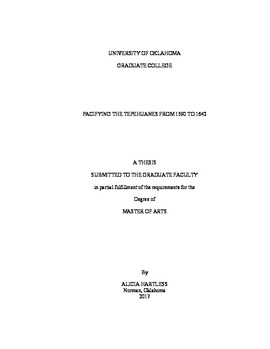| dc.description.abstract | In the sixteenth century, Spanish missionaries entered the northern frontier of Mexico in hopes of converting the “barbarous” native peoples of the Sierra Madre Occidental. Upon their arrival, they found a population of warlike people, the Tepehuanes, who controlled large amounts of territory near valuable mines. The Spanish soon realized the need to missionize the Tepehuanes in order to gain access to a large labor force and pathways to the mines. Following the outbreak of epidemics among the natives, the Tepehuanes descended from the mountains in the 1590s. In the decades following missionization, the Tepehuanes appeared stable and peaceful to their colonial rulers. But the Tepehuanes continued to make sacrifices to traditional deities. Traditional practices persisted within the mission. Then, in 1616, the Tepehuán Revolt ignited throughout Nueva Vizcaya. The Spanish eventually defeated the Tepehuanes and worked toward total submission and pacification beginning in 1619. However, pacification proved more difficult than the Spanish imagined. | en_US |
